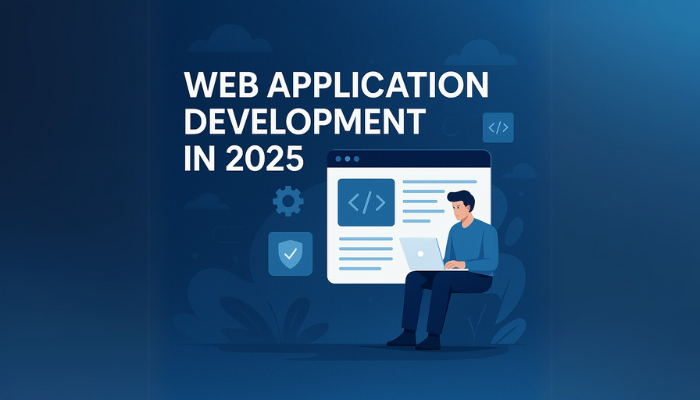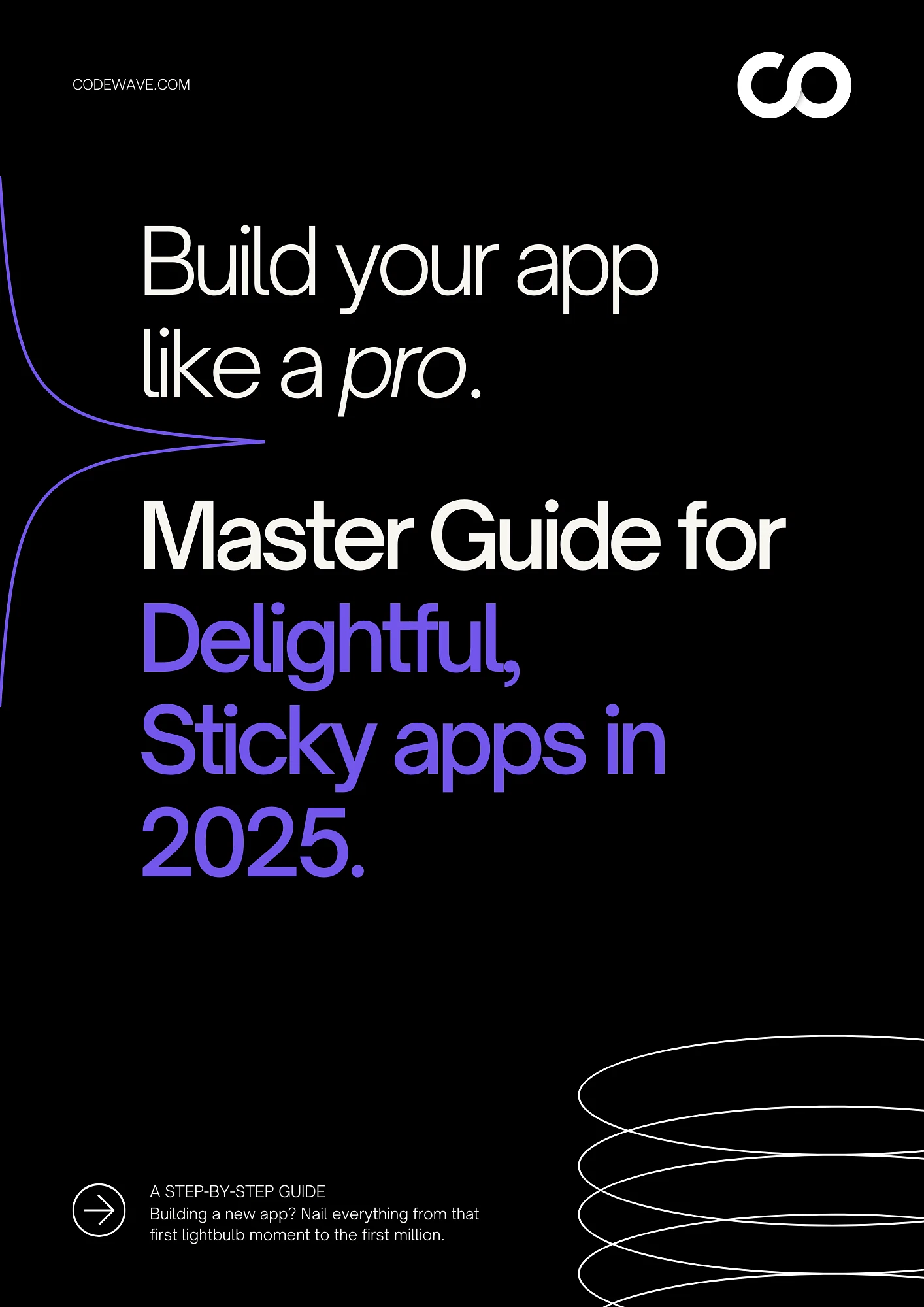Here’s the thing: if your business still treats the web as “just another channel,” you’re not behind, you’re invisible. Mobile devices (not even counting tablets) drove 62.54% of all global web traffic in Q4 2024. Let that sink in for a second.
In 2025, web application development iis a business survival skill. It’s how companies launch faster, serve smarter, and scale without breaking everything in the process. Static websites are outdated, and modern development now emphasizes speed, flexibility, and intelligent user experience (UX) as essential standards for success.
This guide gives you the full operational intelligence: the how, why, and what now of web app strategy in 2025. By the time you’re done reading, you’ll have the roadmap to tackle any web app development project like a pro; with clarity, confidence, and a competitive edge. Ready to dive in? Let’s get started.
What Building for the Web Means in 2025
Let’s clear the fog: web application development in 2025 isn’t just “making websites.” At its core, web application development means creating interactive, browser-based software that behaves like a native app but lives online. Think Google Docs, Slack, or Trello; fast, functional, and accessible without a download.
But let’s get real, terms like app web development, website app development, and app and website development are often thrown around like they’re interchangeable. They’re not.
- App web development focuses on building apps for the web; dynamic tools, dashboards, portals, or platforms users interact with in real time.
- Website app development blends functionality and content. Think of a marketing site that’s also your login hub, file manager, and analytics dashboard; all rolled into one.
- App and website development is the full-stack game: building both user-facing content (website) and functional applications (web/mobile) to deliver an end-to-end experience.
In short: if your business still separates web and mobile efforts, you’re fragmenting your user journey. Users now expect seamless UX, whether they tap an app icon or hit your domain on Chrome.
Here’s how things stack up:
| Feature | Website | Web App | Mobile App |
| Accessibility | Universal | Browser-based | Platform-specific |
| Updates | Manual or CMS | Real-time | App store required |
| Interaction | Mostly static | Fully interactive | Deep native features |
| Development | Front-end heavy | Full stack | Platform-dependent |
| Install Needed | No | No | Yes |
Why Web Application Development Matters in 2025
As user behavior, network capabilities, and business needs evolve, web apps must adapt to new challenges. Here’s why web application development is more crucial than ever:
Four reasons it matters right now:
- Mobile-first reality: Mobile devices drove around 60% of global e-commerce sales in 2023, with projections expecting that number to climb to 63% by 2028.
- 5G changes the game: Ultra-low latency and lightning speeds enable real-time web experiences, from live dashboards to collaborative apps.
- Cost vs. Value: Web applications often present cost advantages over native apps, primarily due to unified codebases and streamlined maintenance, though exact savings can vary based on project specifics.
- Compliance is rising: Digital accessibility is gaining traction, with 36% of companies making executive-level commitments and 48% propelled by grassroots efforts.
Here’s where it gets real, businesses can’t afford to choose between speed, experience, and cost anymore. Users expect seamless performance across devices, while product teams are being asked to ship faster with leaner resources.
That’s why modern app and web development is leaning into web-first architecture, component-based UIs, progressive web apps, headless CMS, and cross-platform logic, to meet rising demands without doubling the workload.
In short: build once, perform everywhere. That’s the web advantage in 2025, and it’s redefining what product velocity looks like.
Different Types of Web Applications in 2025
The landscape of web applications is rapidly evolving. With user expectations at an all-time high and businesses needing to stay agile, understanding the different types of web apps is essential.
Here’s a breakdown of the most relevant types that will shape the future of web application development:
1. Single Page Applications (SPAs)
SPAs are transforming how users interact with web apps by offering seamless, app-like experiences without page reloads. Perfect for dynamic platforms; think social networks, live dashboards, and email clients, SPAs improve performance, reduce load times, and create a smoother user journey. Expect faster, more responsive interfaces, even as your app scales.
2. Progressive Web Applications (PWAs)
PWAs blend the best of both worlds: the accessibility of the web and the native features of mobile apps. They allow offline access, push notifications, and seamless integration with device features, without the need for an app store. PWAs are ideal for businesses that need cross-platform reach but want to bypass the expense and complexity of app stores. The result? Broader reach and cost-effective deployment.
3. E-commerce Platforms
E-commerce continues to be a driving force in web app development, evolving to offer hyper-personalized shopping experiences, real-time inventory tracking, and AI-powered customer service. With consumers expecting intuitive, fast, and responsive online shopping, businesses must prioritize seamless, data-driven user experiences to stay competitive.
4. Cloud-based Web Applications
Cloud apps are the backbone of modern businesses, providing scalability, data accessibility, and improved security. As companies move away from legacy systems, cloud-based apps ensure smooth, secure operations for everything from CRM systems to HR tools, allowing businesses to scale and adapt quickly without worrying about on-premise infrastructure.
5. Real-time Web Applications
Real-time web apps, such as messaging platforms, live notifications, and financial tracking tools, rely on technologies like WebSockets to offer instant updates. This category is key for businesses in high-speed sectors like trading, communications, and customer service, where real-time data processing can significantly improve responsiveness and user satisfaction.
Now that we’ve explored the types of web applications, let’s dive into the comprehensive lifecycle that brings these digital solutions to life.
The Complete Web Application Development Lifecycle
Web apps that scale, convert, and perform don’t happen by accident, they’re built with clarity, strategy, and precision. And in 2025, with digital demands intensifying, you can’t afford a messy or misaligned build process.
Before you jump into code or design tools, get familiar with the web application development lifecycle, a structured roadmap that guides your product from concept to launch (and beyond).
1. Planning
Before you write a single line of code, you’ve got to get crystal clear on the why. This is where your goals, target audience, and app’s purpose come into play. Think of it as the blueprint for the whole project. Without it, you’re just building for the sake of building, and that never ends well.
Key Moves:
- Define clear goals & success metrics
- Set timelines and budgets
- Align the team on scope and deliverables
Why It Matters: Planning keeps the ship on course. Miss this stage, and you risk misalignment, feature creep, and delays.
2. Design
Design isn’t just about making the app look good, it’s about making it work like magic. This is where user experience meets functionality. You create wireframes, prototypes, and flows that ensure users can navigate effortlessly. A well-designed app isn’t just functional, it feels like second nature.
Key Moves:
- Create UX wireframes for smooth user journeys
- Build UI prototypes and refine with feedback
- Test design assumptions early with real users
Why It Matters: Great design saves you from expensive redesigns down the line. If users don’t get it, they won’t use it.
3. Development
Now the magic happens. Development is where front-end and back-end meet. Front-end is all about user interactions and back-end powers the app from behind the scenes. This is when the rubber meets the road: every line of code is a brick in your app’s foundation.
Key Moves:
- Front-end: Develop responsive UI with HTML, CSS, JavaScript
- Back-end: Build logic, APIs, and integrate with databases
- Collaborate in sprints, and iterate fast
Why It Matters: Well-written code is the difference between an app that’s fast, scalable, and secure, and one that crashes under pressure.
4. Testing
Here’s where you find out if all that work was worth it. Testing goes beyond checking boxes. It’s about ensuring functionality, security, and performance. Whether you’re running automated tests or manually clicking through every corner, this stage eliminates bugs and ensures your app can handle real-world chaos.
Key Moves:
- Conduct functional & regression tests
- Perform user acceptance testing (UAT)
- Run security checks & performance audits
Why It Matters: Test early, test often. Bugs found now are way cheaper to fix than after launch.
5. Deployment
Launch day. You’ve built, tested, and optimized, now it’s time to go live. This is a precision operation: servers, databases, domains, and production setups all need to be spot-on. One misstep here can affect your users’ trust.
Key Moves:
- Set up servers, databases, and domain configurations
- Deploy code to production environment
- Monitor performance and be ready to rollback if needed
Why It Matters: A smooth deployment means happy users. A bumpy one means user frustration and potential downtime.
6. Maintenance
Once your app is live, the job isn’t over. Maintenance is how you keep it running smoothly, patch bugs, and scale as you grow. It’s about fixing what’s broken, optimizing what works, and building on user feedback.
Key Moves:
- Monitor app performance and user behavior
- Roll out updates, patches, and scalability improvements
- Stay ahead of emerging tech to keep your app fresh
Why It Matters: Apps aren’t static, they evolve. Ongoing maintenance ensures your app stays relevant, secure, and effective as you scale.
Now that you know the process, let’s look at the tech shaping apps in 2025.
Key Technologies Powering Web Application Development in 2025
The digital landscape is constantly evolving, and staying ahead of the curve is non-negotiable. By 2025, these game-changing technologies will redefine how we build and interact with web applications.
Let’s break down what’s shaping the future of web development.
1. AI and Machine Learning: Personalized UX
AI and Machine Learning aren’t just buzzwords, they’re transforming the user experience from static to dynamic. Imagine an app that understands your needs, adapts to your behavior, and even predicts what you might want next. Whether it’s personalized recommendations, adaptive interfaces, or intelligent chatbots, AI is making apps smarter and more engaging. It’s all about anticipating user needs before they even realize them.
2. Progressive Web Apps (PWAs): Speed and Offline Capabilities
Progressive Web Apps (PWAs) are the next-level hybrid between web and mobile apps. Think of them as the cool, fast cousin who works even when you’re offline. PWAs deliver lightning-fast load times, enhanced performance, and work seamlessly across devices, whether you’re on a desktop or a low-network mobile connection. It’s the ideal way to improve user retention, eliminate friction, and provide a consistent, app-like experience straight from the browser.
Also read: Successful Examples of Progressive Web Apps
3. Serverless Architectures (AWS Lambda, Azure Functions)
Serverless architecture isn’t as much about the servers disappearing as it is about handing off the headaches of server management. With AWS Lambda and Azure Functions, developers can run code without worrying about infrastructure, scaling automatically and only charging for the resources used. This is the tech equivalent of outsourcing the heavy lifting while you focus on building features that matter. No servers, no problem.
4. Web3 Components: Blockchain-Backed Identity Management
Web3 isn’t just a trend, it’s a revolution in how we think about data security and privacy. Blockchain-backed identity management means users control their digital identities with a level of security that centralized systems can’t touch. Forget passwords and single points of failure, Web3 lets users own their identities while cutting down on fraud and protecting data like never before.
5. Headless CMS + JAMstack
When you ditch the traditional CMS and embrace the power of a headless CMS, you’re opening doors to an entirely new level of flexibility and performance. A headless CMS separates content management from presentation, making your site or app faster, more secure, and more scalable. Combined with JAMstack (JavaScript, APIs, and Markup), this architecture delivers static content at lightning speed, making it perfect for modern apps and websites that demand optimal performance.
6. Agentic AI: Autonomous Decision-Making
Agentic AI goes beyond traditional automation by enabling autonomous decision-making. It interacts with users, analyzes real-time data, and makes decisions to achieve business goals without human input. This empowers businesses to streamline operations, automate complex tasks, and deliver personalized experiences, all while enhancing efficiency. Whether improving customer support or driving data-informed decisions, agentic AI is redefining web application functionality and setting the stage for smarter, more efficient workflows.
Cool tech is great, but how much will it actually cost to build your web app?
Costs of Web Application Development in 2025
Web application development has never been more exciting, or more nuanced when it comes to cost. In 2025, pricing is shaped not just by what you build, but how and where you build it.
Here’s a smart breakdown of what’s influencing your budget and what kind of price tag you can expect.
What Drives the Cost?
1. Complexity of Features
The more interactions, data syncs, user roles, and third-party systems involved, the higher the engineering effort. Think: static landing page vs. a fintech-grade dashboard with real-time analytics. The jump is exponential.
2. Tech Stack & Architecture
Going headless, serverless, or AI-powered? Expect higher initial costs—these stacks demand seasoned talent, longer QA cycles, and tight integration standards. But they pay off in scalability and lower long-term TCO (Total Cost of Ownership).
3. Team Location & Experience
- U.S./Western Europe: $80–$200/hour (high-end, product-first teams)
- Eastern Europe/LatAm: $40–$80/hour (cost-effective, skilled devs)
- India/Philippines: $20–$50/hour (best for MVPs or rapid builds)
Offshoring cuts costs, but experienced leadership is still essential to avoid technical debt.
4. Infrastructure & DevOps
Choosing between a traditional server, serverless architecture, or containerized setup (e.g., Docker + Kubernetes) will affect both dev time and ongoing cloud costs. Expect AWS/GCP usage to bring recurring bills for uptime, bandwidth, and autoscaling.
Budget Breakdown: What You’ll Likely Spend
| App Type | Features | Estimated Cost |
| Basic | Static pages, forms, CMS | $8,000–$25,000 |
| Mid-Level | Auth, APIs, dashboards | $25,000–$75,000 |
| Enterprise | Integrations, roles, security | $100,000+ |
The real cost of a web app in 2025 depends on how bold you’re willing to go. Clarity on features, smart tech decisions, and choosing the right dev team will help you control costs without compromising quality.
Common Challenges in Web App Development (And How to Solve Them)
Web apps often run into predictable problems. The good news? Each one has a solid, proven fix:
1. Challenge: Poor User Experience (UX)
A confusing interface or clunky navigation kills engagement fast. Users drop off when they can’t find what they need in seconds.
Fix: Use human-centered design. Start with real user feedback. Create clear flows, wireframes, and test them early to avoid confusing interfaces.
2. Challenge: Security Risks
With increasing cyber threats, poor security can be catastrophic, leading to data breaches, compliance issues, or worse.
Fix: Follow OWASP 2024 security practices. Add things like encrypted data, secure login, and regular vulnerability scans. Make security part of your development, not an afterthought.
3. Challenge: Can’t Handle More Users
As user numbers grow, traditional app architectures may struggle to keep up, causing slowdowns or crashes under heavy traffic. Poor scalability can directly impact user satisfaction and business performance.
Fix: Use microservices and containers like Docker. Break your app into smaller parts that can scale individually. This keeps your system fast even when traffic spikes.
4. Challenge: Complicated, messy code
Over time, messy or poorly organized code can lead to confusion, bugs, and difficulty in maintenance. A lack of structure makes the app harder to scale or update, leading to technical debt.
Fix: Write clean code and automate testing. Use coding standards, regular reviews, and CI/CD tools to keep everything organized and easy to update.
5. Challenge: Hard to connect with old systems
When integrating a new web application with legacy systems, compatibility issues can arise, making it difficult to access and use existing data or features.
Fix: Use APIs and tools like Zapier or MuleSoft. Instead of replacing old tools, link them to your new app with smart integrations.
Once you tackle today’s challenges, it’s worth seeing what tomorrow’s web apps might look like.
Future Outlook for Web Application Development Beyond 2025
Web application development isn’t slowing down; it’s evolving into something faster, smarter, and more human-centric than ever before. By 2026 and beyond, expect these shifts to go mainstream:
- AI-Driven Predictive UX
Web apps will no longer just respond—they’ll anticipate. With generative AI and behavioral analytics, apps will personalize layout, content, and flows in real-time. Gartner predicts that by 2026, over 80% of user interactions will be AI-mediated.
- Sub-Second Load Times as Standard
Speed won’t be optional. With advancements in edge computing and ultra-light frameworks, apps will aim for <0.5 second load times. According to Google, 53% of users leave a site if it takes longer than 3 seconds—that bar is getting much lower.
- Serverless Will Become Default
The shift from infrastructure-heavy to event-driven serverless platforms like AWS Lambda and Azure Functions will dominate. Infact, serverless computing market size is projected to reach $56.41 billion by 2031.
- Universal Accessibility by Design
With WCAG 3.0 rolling out, accessibility won’t be a checklist, it’ll be built into the design DNA. Expect mandates across industries as inclusive design becomes a legal and brand standard.
How to Choose the Right Web App Development Partner
“If you think good design is expensive, you should look at the cost of bad design.”
Choosing a web app development partner isn’t just about skill, it’s about synergy. For B2B enterprises, here’s a razor-sharp checklist to filter out the fluff:
- Industry-Specific Experience: Ensure the partner has proven case studies in your domain (e.g., EdTech, BFSI, HealthTech). This reduces ramp-up time and ensures relevant expertise.
- Agile + DevSecOps Integration: The partner should be adept in agile methodologies while integrating security throughout the development lifecycle with practices like CI/CD and automated code reviews.
- UX-First Approach: Prioritize firms that lead with user experience, conducting user research, testing, and iterative design to ensure a seamless, intuitive interface.
- Scalable Solutions: Look for partners that prioritize long-term scalability, utilizing microservices or cloud-native architectures to ensure flexibility for future growth.
- Transparent Pricing: Ensure clear, upfront pricing with no hidden fees, covering development, testing, and maintenance. Avoid partners that allow tech debt to pile up unnoticed.
“Don’t find customers for your products, find products for your customers.”
Leading firms like Codewave embody this mindset. Founded in 2013, Codewave brings Design Thinking-led digital innovation to life, blending UX, AI/ML, cloud, and blockchain to build future-ready solutions.
- Built smart IoT solutions for AgriTech firms
- Designed GenAI-led experiences for BFSI
- Delivered HIPAA-compliant HealthTech platforms
- Offers penetration & QA testing, not just dev
With awards from Clutch, GoodFirms, and Tech Behemoths, Codewave delivers both credibility and capability.
Ready to build what your customers actually need? Talk to Codewave.
Final Say
The web isn’t just where business happens; it’s where brands are built, scaled, and remembered. In 2025 and beyond, your application isn’t just a tool. It’s your frontline.
Codewave stands out with its design thinking DNA and engineering depth. From custom software development to ReactJS and UX-first web solutions, we help B2B brands launch intelligent apps built for scale and performance.
Looking to lead, not lag? Build with Codewave, where product vision meets precision execution. Get in touch.
Also, an insightful read: Custom Web Application Development: Process, Cost and Timeline Guide
Codewave is a UX first design thinking & digital transformation services company, designing & engineering innovative mobile apps, cloud, & edge solutions.







